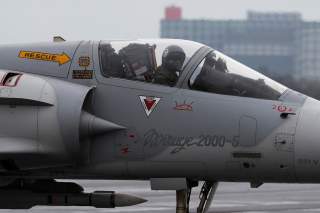China Bought Russia's S-400 Missiles, Taiwan Now Needs More SAMs
Missiles over fighters.
Key point: The short distance separating China and Taiwan works both ways.
The Chinese military's new S-400 surface-to-air missile system can hit targets more than 150 miles away, if the reported result of the type's first-ever test in Chinese service is accurate.
The Taiwan strait is just 140 miles across at its widest point, meaning that, in theory, Chinese S-400s could target Taiwanese warplanes shortly after they take off.
But the short distance separating China and Taiwan works both ways. At the same time that China is fielding S-400s and other long-range surface-to-air missiles, Taiwan is deploying air-and surface-launched munitions that can target the Chinese missile launchers.
The People’s Liberation Army’s rocket force conducted its first live-fire drill with its first regiment of Russian made S-400s in November 2018, The Diplomat reported, citing Russian sources.
A Russian-style missile regiment usually includes two battalions together possessing 16 launchers. An S-400 launcher packs four missiles at a time.
According to The Diplomat, a Chinese S-400 intercepted a "simulated ballistic target" around 250 kilometers, or 155 miles, away. The Taiwan Strait separating Taiwan from the Chinese mainland varies between 81 and 140 miles wide.
Annexing Taiwan is the primary military ambition of the Chinese Communist Party. Chinese war plans apparently anticipate a massive air and missile bombardment of Taiwanese defenses followed by an amphibious assault across the strait under heavy fighter cover.
To defend against attack, the Taiwanese air force operates around 330 F-CK, F-16 and Mirage 2000 fighters, a not insignificant force. Taipei is upgrading its F-16s and F-CKs with new sensors and weapons. But at first glance, China possesses the aerial advantage in a cross-strait battle.
"Taiwan faces one of the most difficult air-defense problems in the world," the California think-tank RAND reported in 2016. "What makes Taiwan’s air-defense problem so difficult is the combination of its proximity to China, coupled with the massive investments that the People’s Republic of China has made in a range of systems that threaten Taiwan’s aircraft—not just while they are in the air but also while they are on the ground."
Assuming Taiwanese fighters survive the first round of Chinese attacks, either by dispersing to highways or caves or through some heroic defensive effort by Taiwan's own surface-to-air missile batteries, the planes still must contend with Chinese SAMs, now including S-400s, firing missiles across the strait.
"On the slight chance that an aircraft could get off the ground, it is likely to face attack before it can reach altitude or combat speeds," RAND concluded.
To counter this daunting threat, Taiwan has invested heavily in missiles that are capable of suppressing Chinese SAM sites. The Taiwanese arsenal includes hundreds of ground-launched ballistic missiles with sufficient range to strike Chinese S-400s.
Taiwan's fighters are getting ground-attack cruise missiles. In 2014, the Taiwanese air force finished modifying 71 F-CK fighters to carry new Wan Chien stand-off air-to-surface missiles. The air force planned to modify the other 56 F-CKs to a similar standard by 2017.
The Wan Chien missile system bolsters the fighter fleet by "increase[ing] combat effectiveness and [providing] the capability to strike airports, harbors and missile and radar positions," according to Jane's.
But RAND advised Taiwan's leaders to try winning the fighter battle ... by not fighting it, and investing in surface-to-air missiles instead of warplanes. China's S-400s would have nothing to shoot at, while Taiwan's own SAM batteries plucked Chinese fighters from the sky.
"Although it might be painful for leaders in Taiwan to think of a major divestment of its fighter force, the expectations about the efficacy of that force need to be curtailed," the think tank recommended. "There is a substantial opportunity cost for keeping the current, large fighter force, which will limit needed SAM investment that could offer greater air-defense protection in the most intense scenarios."
"To continue to provide a credible deterrent and be seen as having the potential to contest its own airspace, Taiwan needs to invest in and invigorate its SAM force. These should get priority over fighters."
David Axe edits War Is Boring . He is the author of the new graphic novels MACHETE SQUAD and THE STAN. This first appeared in 2018.
Image: Reuters.

